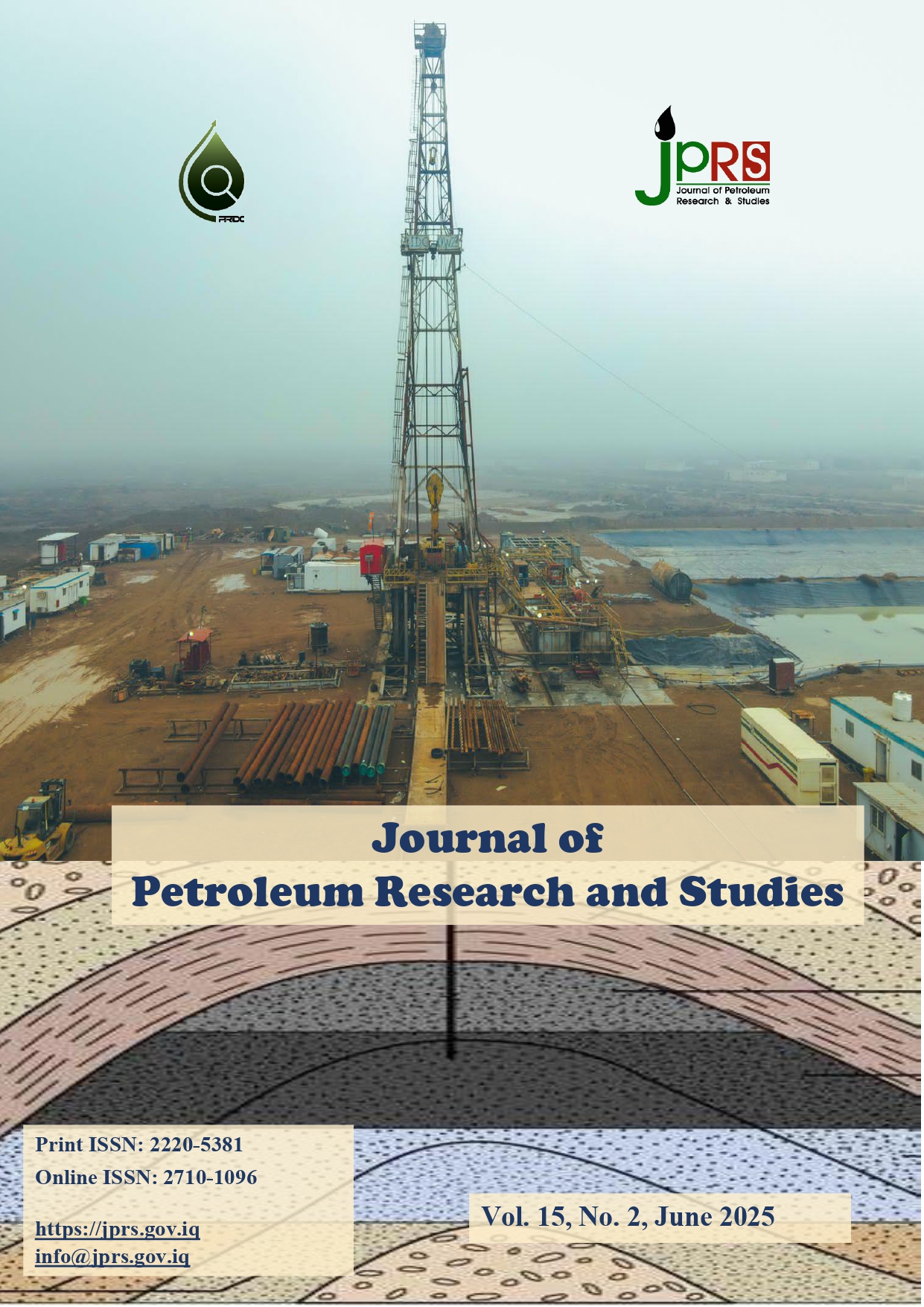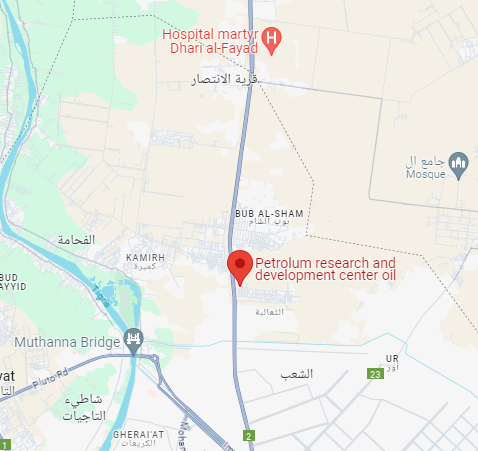مقارنة تجريبية بين حقن السائل الأيوني والسوائل النانوية في حقل الناصرية النفطي : تطبيق لتحسين استخلاص النفط
DOI:
https://doi.org/10.52716/jprs.v15i2.892الكلمات المفتاحية:
Interfacial tension (IF); Surface tension ; Enhanced oil recovery ; Ionic liquid (IL) ; Dodecyl pyridinium chloride .الملخص
وصلت العديد من حقول النفط حول العالم إلى مرحلة النضج وتوقفت عن إنتاج النفط اقتصادياً. فمن الضروري استخراج النفط الخام من تقنيات الاستخلاص الثلاثي بالإضافة إلى المرحلتين الأولية والثانوية لتلبية الطلب المتزايد على الطاقة في جميع أنحاء العالم، مما يؤدي إلى ارتفاع أسعار النفط. ولهذا السبب، سيصبح الاستخلاص المعزز للنفط أكثر أهمية في السنوات القادمة. ولزيادة استخلاص النفط، فإن الأسلوب الممكن هو حقن المواد الكيميائية في المكامن .
تناول البحث الحالي تأثير السائل الأيوني (كلوريد دوديسيل بيريدينيوم) وحده والموائع النانوية المحضرة من (50 جزء في المليون من جسيمات الكربون النانوية CNPs مع مجموعة من تراكيز السائل الأيوني) على التوتر السطحي ومن ثم تطبيقه في الاستخلاص المعزز للنفط.تظهر النتيجة أن كلوريد دوديسيل بيريدينيوم يغير التوتر السطحي (IFT) من 3.13 إلى 1.25 داين/سم عند 250 جزء في المليون. في المقابل، فإن تركيبة السوائل النانوية المثالية (50 جزء في المليون من الكربون النانوي مع 250 جزء في المليون من السائل الأيوني) خفضت التوتر السطحي من 55.07 إلى 39.85 داين/سم عند 25 درجة مئوية.
وأخيرا، تم إجراء اختبارات الفيضانات الأساسية. تم تحقيق استرداد إضافي للنفط بنسبة 5.58% و20.5% من الزيت الأصلي الموجود في مكانه بعد حقن PV2 من السائل الأيوني فقط وتركيبة السائل النانوي الأمثل بنفس معدل التدفق، على التوالي.
وفي الوقت نفسه، بلغ معدل الاستخلاص الإضافي للنفط 21.67% بعد حقن PV4 من السائل النانوي الأمثل. ووفقا للبحث، فإن هذه السوائل النانوية تعد واعدة للغاية بالنسبة للاستخلاص المعزز للنفط.
المراجع
A. Al-Asadi, A. Arce, E.Rodil, and A.Soto, “Enhanced oil recovery with nanofluids based on aluminum oxide and 1-dodecyl-3-methylimidazolium chloride ionic liquid”, Journal of Molecular Liquids , vol. 363, October, 2022. https://doi.org/10.1016/j.molliq.2022.119798
N. V. Plechkova, and K. R Seddon, “Applications of ionic liquids in the chemical industry”, Chemical Society Reviews, vol. 37, no. 1, pp. 123-150, 2008.
A. Bera, and H. Belhaj, “Ionic liquids as alternatives of surfactants in enhanced oil recovery—A state-of-the-art”, Journal of Molecular Liquids, vol. 224, pp. 177-88, 2016. https://doi.org/10.1016/j.molliq.2016.09.105
A. Z. Hezave, S. Dorostkar, S. Ayatollahi, M. Nabipour, and B. Hemmateenejad, “Investigating the effect of ionic liquid (1-dodecyl-3- methylimidazolium chloride ([C12mim][Cl])) on the water/oil interfacial tension as a novel surfactant”, Colloids and Surfaces A: Physicochemical and Engineering Aspects, vol. 421, pp. 63-71, 2013. https://doi.org/10.1016/j.colsurfa.2012.12.008
M. Yousefi, A. Naseri, M. Abdouss, and A. A. M. Beigi, “Synthesis and characterization of eight hydrophilic imidazolium-based ionic liquids and their application on enhanced oil recovery”, Journal of Molecular Liquids, vol. 248, pp. 370-377, 2017. https://doi.org/10.1016/j.molliq.2017.10.069
S. Sakthivel, S. Velusamy, V. C. Nair, T. Sharma, and J. S. Sangwai, “Interfacial tension of crude oil-water system with imidazolium and lactambased ionic liquids and their evaluation for enhanced oil recovery under high saline environment”, Fuel, vol. 191, pp. 239-250, 2017. https://doi.org/10.1016/j.fuel.2016.11.064
C. S. Buettner, A. Cognigni, C. Schröder, and K. Bica-Schröder, “Surface-active ionic liquids: A review”, Journal of Molecular Liquids, vol. 347, p. 118160, 2022. https://doi.org/10.1016/j.molliq.2021.118160
M. K. Uoda, H. Q. Hussein, and R. R. Jalil, “Study of the effect of ionic liquid on the wettability alteration of carbonate reservoir”, Chem. Pap., vol. 77, pp. 3663–3669, 2023. https://doi.org/10.1007/s11696-023-02728-0
C. P. Whitby, D. Fornasiero, and J. Ralston, “Effect of adding anionic surfactant on the stability of Pickering emulsions”, Journal of Colloid and Interface Science, vol. 329, no. 1, pp. 173–181, 2009. https://doi.org/10.1016/j.jcis.2008.09.056
W. Qiao, Y. Cui, Y. Zhu, and H. Cai, “Dynamic interfacial tension behaviors between Guerbet betaine surfactants solution and Daqing crude oil”, Fuel, vol. 102, pp. 746–750, 2012. https://doi.org/10.1016/j.fuel.2012.05.046
T. Sharma, G. Suresh Kumar, and J. S. Sangwai, “Enhanced oil recovery using oil-in water (o/w) emulsion stabilized by nanoparticle, surfactant and polymer in the presence of NaCl”, Geosystem Eng., vol. 17, no. 3, pp. 195–205, 2014. https://doi.org/10.1080/12269328.2014.959622
S. Al-Anssari, S. Wang, A. Barifcani, M. Lebedev, and S. Iglauer, “Effect of temperature and SiO2 nanoparticle size on wettability alteration of oil-wet calcite”, Fuel, vol. 206, pp. 34–42, 2017. https://doi.org/10.1016/j.fuel.2017.05.077
M. Zargartalebi, R. Kharrat, and N. Barati, “Enhancement of surfactant flooding performance by the use of silica nanoparticles”, Fuel, vol. 143, pp. 21– 27, 2015. https://doi.org/10.1016/j.fuel.2014.11.040
B. Haq, M. A. Aziz, D. Al Shehri, N. S. Muhammed, S. I. Basha, A. S. Hakeem, M. A. A. Qasem, M. Lardhi, and S. Iglauer, “Date-Leaf Carbon Particles for Green Enhanced Oil Recovery,” Nanomaterials, vol. 12, no. 8, 2022, https://www.mdpi.com/2079-4991/12/8/1245
N. Pal and A. Mandal, “Enhanced oil recovery performance of gemini surfactant stabilized nano emulsions functionalized with partially hydrolyzed polymer/silica nanoparticles”, Chemical Engineering Science, vol. 226, p. 115887, 2020. https://doi.org/10.1016/j.ces.2020.115887
M. Kh. Uoda, H.Q. Hussein, R. R. Jalil, “Experimental investigation of combined carbon nanoparticles (CNPs), ionic liquid (I.L), and low salinity water to enhance oil recovery (EOR) at Iraq's southern oil fields”, Journal of Molecular Liquids, vol. 391, Part A, p.123322, 2023. https://doi.org/10.1016/j.molliq.2023.123322
M. Kh. Uoda, H.Q. Hussein, R. R. Jalil, “Synthesis and characterization of nanocarbon from waste batteries via an eco-friendly method”, Waste Dispos. Sustain. Energy, vol. 6, pp. 197-208, 2024. https://doi.org/10.1007/s42768-023-00180-0
H. Soleimani, M. K. baig, N. Yahya, L. Khodapanah, M. Sabet, B. M. R. Demiral and M. Burda, “Impact of carbon nanotubes based nanofluid on oil recovery efficiency using core flooding”, Results in Physics, vol. 9, pp. 39–48, 2018. https://doi.org/10.1016/j.rinp.2018.01.072
U. Alameedy, A. A. Alhaleem, A. Isah, A. Al-Yaseri, M. Mahmoud, and I. Salih, “Effect of acid treatment on the geomechanical properties of rocks: an experimental investigation in Ahdeb oil field”, Journal of Petroleum Exploration and Production Technology, vol. 12, no. 12, pp. 3425–3441, 2022. https://doi.org/10.1007/s13202-022-01533-x
Y. Ding, X. Sun, L. Zhang, Sh. Mao, Z. Xie, Z. W. Liu and D. S. Su., “Entrapping an ionic liquid with nanocarbon: The formation of a tailorable and functional surface”, Angewandte Chemie, vol. 127, no. 1, pp. 233-237, 2015. https://doi.org/10.1002/ange.201408201
L. Shi, Y. F. Zhu, C. Zhang, and J. Liang, “Heterocoagulation system assisted adsorption of carbon nanotubes on alumina for toughening ceramics”, Journal of Reinforced Plastics and Composites, vol. 27, no. 3, pp. 245–253, 2008. https://doi.org/10.1177/0731684407079478
A. R. Wattan, M. S. aljwad, and U. S. Alameedy, “A Numerical Study of Tertiary Oil Recovery by Injection of Low-Salinity Water”, Journal of Petroleum Research and Studies, vol. 13, no. 1, pp. 32-55, Mar. 2023. https://doi.org/10.52716/jprs.v13i1.674
F. H. Almahdawi, U. Alameedy, A. Almomen, A. A. Al-Haleem, A., A. Saadi, and Y. M. F. Mukhtar, “The Impact of Acid Fracking Injection Pressure on the Carbonate-Mishrif Reservoir: A Field Investigation”, In: International Petroleum and Petrochemical Technology Conference IPPTC, Springer, Singapore, 2022. https://doi.org/10.1007/978-981-99-2649-7_54
M. Mirzavandi, J. A. Ali, A. K. Manshad, B. Majeed, B. S. Mahmood, A. H. Mohammadi, S. Iglauer, and A. Keshavarz, “Performance Evaluation of Silica–Graphene Quantum Dots for Enhanced Oil Recovery from Carbonate Reservoirs”, Energy Fuels, vol. 37, no. 2, pp. 955–964, 2023. https://doi.org/10.1021/acs.energyfuels.2c03150
K. Liao, Z. Ren, L. Fu, F. Peng, L. Jiang, W. Gu, X. Zhang, J. Bai and Y. He, “Effects of surfactants on dispersibility of graphene oxide dispersion and their potential application for enhanced oil recovery”, Journal of Petroleum Science and Engineering, vol. 213, pp. 1–7, 2022. https://doi.org/10.1016/j.petrol.2022.110372
M. Kh. Uoda, H. Q. Hussein, and R. R. Jalil, “Ionic Liquids for Enhanced Oil Recovery: An Experimental Study”, Kongzhi yu Juece/Control and Decision, vol. 38, no. 1, April, 2023.
التنزيلات
منشور
كيفية الاقتباس
إصدار
القسم
الرخصة
الحقوق الفكرية (c) 2025 Maraim Kh. Uoda, Hussein Q. Hussein, Rana R. Jalil

هذا العمل مرخص بموجب Creative Commons Attribution 4.0 International License.














